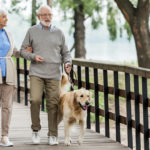Five minutes of exercise in a natural setting–like walking in a park or gardening in your backyard–benefits mental health as well as physical health.
A recent study from the money-spent-to-prove-what-we- already-know-but-refuse-to-believe department shows that just five minutes of exercise in nature makes people feel better . According to study authors Jules Pretty and Jo Barton of the University of Essex in England, five minutes of exercise in a natural setting — like walking in a park or gardening in your backyard — benefits mental health. The surprising thing here, if you can call it surprising, is the importance of where the exercise takes place.
A 2008 study by the same department found similar effects. In that study, participants walked for 30 minutes in either an indoor shopping mall, or a country park. Ninety percent of those who walked in nature experienced improved self-esteem, and 71 percent felt less depressed, but only 45 percent of the shopping center walkers experienced a mood lift. In the current study, Drs. Pretty and Barton analyzed 1,252 people of different ages, genders, and mental health status who participated in 10 different UK studies. Their conclusion was that exercise in the presence of nature led to mental and physical health improvements. Said Pretty, “For the first time in the scientific literature, we have been able to show dose-response relationships for the positive effects of nature on human mental health.” (Only a scientist could refer to a walk in the park as a “dose-response relationship.”)
In fact, the results showed that five minutes of exertion in nature was all it took to improve self-esteem, and in fact, that was the optimal dose. The scientists looked at a variety of types of exercise including walking, gardening, cycling, fishing, boating, horse-riding, and farming. They found that while all ages and social groups benefited, the young and the mentally ill experienced the greatest mental health benefits. And while all exposure to nature was beneficial — including visiting green space in urban settings — exposure to environments with green space and water seemed to convey even more benefit. And, no, the artificial plant display with the fake fountain in the middle of the mall doesn’t count.
According to the study, mental health benefits from nature in a multiple ways. Self-esteem improves, and in fact, two out of three subjects had improved self-esteem after walking in nature, two out of three had improved mood, and three out of four felt less depressed and anxious.
The results should get the attention of policy makers, according to Pretty and Barton. “We know from the literature that short-term mental health improvements are protective of long-term health benefits,” Pretty said. “So we believe that there would be a large potential benefit to individuals, society, and to the costs of the health service if all groups of people were to self-medicate more with green exercise,” added Barton. (Too bad the study came out after the national health care debate in the U.S. Imagine all the fun each side could have had telling the other to “take a hike,” so to speak.)
An earlier UK study, Green Exercise: Complementary Roles of Nature, Exercise and Diet in Physical and Emotional Well-Being and Implications for Public Health Policy, published by two divisions of the Department of Biological Sciences at the University of Essex, promoted the same idea in 2003 and did not shy away from its broader implications. According to the study, “Green exercise is likely to have important public and environmental health consequences. A fitter and emotionally more content population costs the economy less. Increasing the support for and access to a wide range of green exercise activities for all sectors of society will produce substantial public health benefits.”
So why don’t individuals simply incorporate a five-minute stint in nature daily to feel significantly better?
Perhaps it’s because so many people don’t exercise at all — nature or no nature, and so even five minutes seems a stretch, let alone having to drive to a “green” area to exercise for those five minutes. According to the U.S. Centers for Disease Control, only 32.5 percent of adults engage in regular leisure time physical activity. On the other hand, 36 percent of adults engage in NO leisure time physical activity. Worse still, 59% of adults aged 18 and older NEVER engaged in vigorous physical activity lasting ten minutes in an average week. When looked at from the point of view of gender, 53% of men and 64% of women NEVER engaged in vigorous physical activity lasting ten minutes or in an average week.
Clearly, the latest study isn’t news so much as it is a reminder of what we’ve known for quite a while. Yes, the public health benefits would be tremendous, and we’d probably save the health care system beaucoup bucks if more people took advantage of green exercise. Heck, maybe even the politicians would give a more vigorous public health care option a second thought if they took advantage of the mental health benefits associated with a nice walk outdoors themselves. Then again, why not just rent Blue Lagoon? It’s got greenery, water, and you get to watch Brooke Shields exercising. Plus, you can eat a large bowl of buttered popcorn at the same time.











